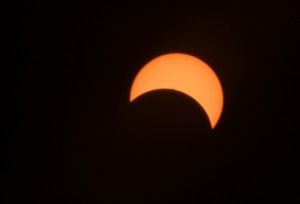As a city that has embraced the titles of neon capital and 24-hour town, Las Vegas might be the antithesis of a stargazing destination. But its neighbor Boulder City is angling to become one after it received $1.9 million from the U.S. Economic Development Administration to update city lights with “energy-efficient light pollution-reducing fixtures,” according to a city press release.
In doing so, it will save energy and benefit wildlife, while potentially bringing more dark skies tourism to the region. The retrofit will get underway in 2023 and is an important step in the city’s push to become the first in Nevada certified as a Dark Skies Community by the International Dark-Sky Association (IDA).
“There’s no question that the biggest problem in the local area here in Southern Nevada is the light dome that comes from Las Vegas,” says IDA delegate Kevin Swartz, who oversees activity in Nevada. “Boulder City is far enough away that they’ll see some benefits from this.”
Swartz adds that “Nevada does have a couple of IDA-certified sites—Massacre Rim and Great Basin … [but] there haven’t been a lot of [other] IDA applications. Boulder City’s is the first one I’m aware of.”
In contrast to the state’s remote, largely uninhabited IDA sites, Boulder City would be the first community to shoot for the designation. According to the association, an IDA Dark Sky Community is a “town, city, municipality or other legally organized community that has shown exceptional dedication to the preservation of the night sky through the implementation and enforcement of a quality outdoor lighting ordinance, dark sky education and citizen support of dark skies.”
The Las Vegas Astronomical Society, of which Swartz is also a member, could help fulfill that education requirement. The group visits schools and hosts monthly “star parties” in Clark County to provide a free opportunity to look through a telescope, marvel at the night sky and learn about astronomy.
“Looking through the telescope at the moon and the stars generates a level of enthusiasm and interest in school-age children. … Hopefully, we’re creating some budding amateur astronomers,” he says, adding that dark night skies provide a hands-on way to teach valuable STEM subjects (Science, Technology, Engineering and Math).
The Astronomical Society also hosts star parties and programming at Lake Mead National Recreation Area at least once a year, Swartz says.
The park also will play a role in educating visitors about dark skies and dark skies recreation with a $31,480 grant from the National Park Foundation for “youth night sky recreation.” Ivan Kassovic, Lake Mead’s chief of staff, says Boulder City’s initiative could enhance that program and “be an advantage to park visitors in several ways.”
“We’ll be bringing out students and teachers to help visitors to the National Park understand the benefits of this,” Kassovic says.
Economic Impact
An IDA Dark Sky Community certification for Boulder City could also lead to increased visitation for Lake Mead and surrounding public lands, and stimulate the outdoor recreation economy, officials say.
“Lake Mead National Recreation Area—the oldest and fifth-most-visited park in the country—is an asset to Nevada overall,” says Colin Robertson, administrator of the Nevada Division of Outdoor Recreation, which helped Boulder City apply for the grant from the U.S. Economic Development Administration.
“Boulder City has really taken the lead to see itself as a gateway community to a very important gem in the National Park system,” Robertson says. “Almost all gateway communities experience job growth, business growth and increases in tourism, because of their gateway status.”
Additional visitation to Boulder City and the lake—and Las Vegas, which provides shuttle buses for tourists to visit the nearby sites—would be a win for mountain biking, kayaking and other outdoor recreation businesses that operate there, and for Nevada’s economic development as a whole, Robertson explains. In November, the U.S. Bureau of Economic Analysis reported that the outdoor recreation sector added $4.9 billion to Nevada’s economy in 2021.
With the recent announcement of President Biden’s intent to designate Avi Kwa Ame, or “Spirit Mountain,” as a national monument, dark skies opportunities will be preserved and further expanded in the federally managed lands near Boulder City.
That excites the Astronomical Society and dark sky enthusiasts.
“We’ve been involved in [Avi Kwa Ame] and looking forward to that becoming a national park. And, hopefully, they’ll pursue a dark-sky certification as well,” Swartz says, adding that Gold Butte would be another prime location to add to Nevada’s growing list of IDA sites.
Quality of Life, Environmental Benefits
The city and chamber of commerce’s partnership with the National Park Natural Sounds and Night Skies Division was instrumental in getting the lighting project off the ground, according to Jill Lagan, CEO of the Boulder City Chamber of Commerce. She says it will “contribute to quality of life for our residents with improved safety and reduced energy costs, as well as enhanced natural beauty and historic character.”
Ashley Pipkin, a biologist with the Natural Sounds and Night Skies Division, has been educating the chamber and city about best practices for their lighting project, and helping them reach their goal of becoming IDA certified.
Although she could not be reached for comment for this article, Pipkin told the Las Vegas Sun in October that she sees the project as a “win-win” for the natural habitat, outdoor recreation and residents who “just want to have better lighting in their community and a more improved environment that makes it more beautiful at night time.”
Furthermore, the use of “responsible outdoor lighting” can be connected to enhanced property values, according to the Colorado Plateau Dark Sky Cooperative.
The natural environment and wildlife could also stand to benefit. According to an IDA educational video about “losing” dark skies, light pollution and unshielded lights disrupt plant growth and contribute to the deaths of “countless land and sea animals each year.”
Click HERE to subscribe for free to the Weekly Fix, the digital edition of Las Vegas Weekly! Stay up to date with the latest on Las Vegas concerts, shows, restaurants, bars and more, sent directly to your inbox!


